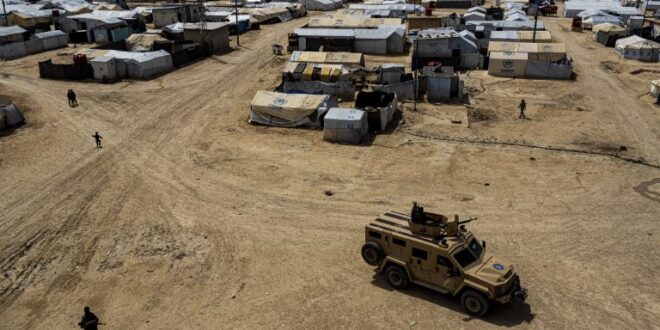- The United States government has repatriated twelve people from detention camps in northeastern Syria, including ten individuals from the same family, in what was the largest single repatriation of U.S. citizens since the collapse of the Islamic State’s so-called caliphate in March 2019.
- The United States is now urging countries to follow Washington’s lead in repatriating their citizens, especially as the conditions in these camps are often described in dire terms, making them potential vectors of extremism and radicalization.
- Of the recent group of Americans just repatriated, a woman in her twenties was arrested upon returning to the country and charged with training with the Islamic State abroad, after the U.S. discovered evidence that she completed military training and belonged to the all-female battalion Khatiba Nusaybah.
- The issue of repatriation has remained largely controversial, especially in many Western countries, where accepting citizens who went to fight alongside the Islamic State is viewed as a political vulnerability.
The United States government has repatriated twelve people from detention camps in northeastern Syria, including ten individuals from the same family. This was the largest single repatriation of U.S. citizens since the collapse of the Islamic State’s so-called caliphate in March 2019. The U.S. also facilitated the repatriation of 6 Canadians, 4 Dutch citizens, and 1 person from Finland, all to their home countries. U.S. Secretary of State Antony Blinken said: “The only durable solution to the humanitarian and security crisis in the displaced persons camps and detention facilities in northeast Syria is for countries to repatriate, rehabilitate, reintegrate and, where appropriate, ensure accountability for wrongdoing.” While the lion’s share of those detained are Iraqi and Syrian, there are roughly 9,000 individuals from across 60 different countries.
The detention camps in northeastern Syria, including the infamous al-Hol camp, are administered by the Syrian Democratic Forces (SDF), a Kurdish-led militia. While estimates vary, reporting suggests that the camps hold approximately 45,000 people, including women and children. In news that was less widely reported in the Western press, mediation by tribal elders in Deir Al-Zour resulted in “scores of women and children linked to the Islamic State” being released from al-Hol.
In detention centers like al-Roj, detainees have participated in hunger strikes to protest living conditions. There have been numerous instances of violence and threats, adding to the concern of governments considering repatriation. Furthermore, there are few examples of successful reintegration programs to point to, which can be costly, tenuous, and often fall short of rigorous standards of measurement, evaluation, and assessment in terms of what works and what does not. In most cases, repatriation is a policy problem that most politicians prefer not to deal with, and to leave to their successors to handle. Many see little upside in the potential risks associated with returning their citizens who have been implicated in fighting for IS. Even women and children have been a complicated issue.
Since 2016, the United States has repatriated 51 Americans, including 30 children and 21 adults. The U.S. is now urging countries to follow Washington’s lead in repatriating their citizens, especially as the conditions in these camps are often described in dire terms, making them potential vectors of extremism and radicalization. Of the recent group of Americans just repatriated, a woman in her twenties named Halima Salman, was arrested upon returning to the country. She was charged with training with the Islamic State abroad, after the U.S. discovered evidence that she completed military training and belonged to an all-female battalion led by another American citizen, Allison Fluke-Ekren, who was in charge of the Khatiba Nusaybah.
The camps, along with detention centers holding approximately 9,000 Islamic State fighters, have been described as a “ticking time bomb,” particularly dangerous because IS understands the value of these prisons and has launched attacks in the past designed to free fighters and detainees by overrunning jails where the militants are held. In late January 2022, jihadists laid siege to the Hasakah Provincial Internal Security Forces detention center, controlled by the SDF. During the course of the assault, fighters detonated multiple vehicle-borne improvised explosive devices (VBIEDs) in tandem with a complex assault by as many as 200 insurgents. The operation was well-resourced and well-planned and, for those who have studied the Islamic State’s strategy for years, eerily reminiscent of the group’s “Breaking the Walls” campaign that helped provide it with battle-hardened fighters that joined its ranks.
Adding to the sense of urgency, IS in Syria is enjoying something of a resurgence, increasing its operational tempo and the frequency of attacks. The issue of repatriation has remained largely controversial, especially in many Western countries, where accepting citizens who went to fight alongside the Islamic State is viewed as a political vulnerability. This is especially true with the rise of far-right populist leaders who have grown in popularity for their hard stance on migration issues. In Europe, there are worries about lacking enough evidence for what would be considered sufficient prison sentences. In other cases, jihadists who have spent time in prisons in Europe for previous offenses are now becoming eligible for release. Without clear guidance from national governments on how to proceed, the status quo will likely lead to a more dangerous situation over the long term.
 Eurasia Press & News
Eurasia Press & News




